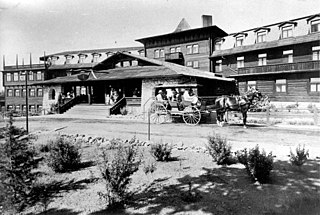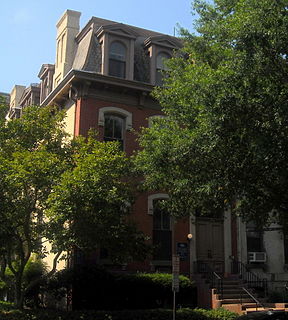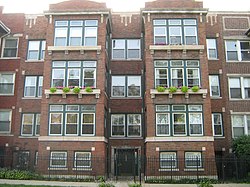Description and history
The Oscar Stanton De Priest House is located on Chicago's South Side community area of Grand Boulevard, on the west side of King Drive south of 45th Street. It is an architecturally unexceptional three-story masonry structure, built of brick with stone trim, with a full basement. It houses eight units, two to each floor including the basement. Its dominant features are projecting rectangular bays on either side of the recessed entry, with bracketed flower boxes on the second and third floors, and a bracketed cornice below the roof. Based on its styling, it was built about 1920. [4]
Oscar Stanton De Priest lived with his wife, Jessie De Priest, in one of the second-floor units of this building from 1929 until his death in 1951. A native of Alabama, he migrated to Chicago in the late 19th century, where he gained employment as a building contractor. He became active in local politics, winning election as a Cook County commissioner in 1904. IN 1915 he was the first African-American to win a seat on Chicago's Board of Aldermen, representing the city's wealthy Second Ward. In 1928 De Priest was chosen as a late replacement on the Republican Party ticket in the election to Illinois's first Congressional district, replacing the incumbent Martin B. Madden, who died shortly after the primary. De Priest won, and was seated in Congress over the objections of Southern representatives. As the first post-Reconstruction African-American in that body, and the first from any northern state, De Priest became a prominent voice on matters of interest to African Americans, working in particular to secure equitable funding for the education of blacks. De Priest served three terms in Congress, before returning to city politics. [4]

Oscar Stanton De Priest was an American politician and civil rights advocate from Chicago. A member of the Illinois Republican Party he was the first African American to be elected to Congress in the 20th century. During his three terms, he was the only African American serving in Congress. He served as a U.S. Representative from Illinois' 1st congressional district from 1929 to 1935. De Priest was also the first African-American U.S. Representative from outside the southern states and the first since the exit of North Carolina representative George Henry White from Congress in 1901.

Grand Boulevard, located on the South Side of Chicago, Illinois, is one of the well-defined Chicago Community Areas. The boulevard from which the community area takes its name now bears the name of Martin Luther King, Jr. Drive. The area is bounded by 39th to the north, 51st Street to the south, Cottage Grove Avenue to the east, and the Chicago, Rock Island & Pacific Railroad tracks to the west.

The El Tovar Hotel, also known simply as El Tovar, is a former Harvey House hotel situated directly on the south rim of the Grand Canyon in Arizona, United States.

The Joseph F. Glidden House is located in the United States in the DeKalb County, Illinois city of DeKalb. It was the home to the famed inventor of barbed wire Joseph Glidden. The barn, still located on the property near several commercial buildings, is said to be where Glidden perfected his improved version of barbed wire which would eventually transform him into a successful entrepreneur. The Glidden House was added to the National Register of Historic Places in 1973. The home was designed by another barbed wire patent holder in DeKalb, Jacob Haish.

The George H. Pendleton House is a historic house at 559 Liberty Hill in the Prospect Hill Historic District of Cincinnati, Ohio. It was built in 1870 in the French Second Empire style. From 1879 until his death in 1889, this was the residence of Senator George Hunt Pendleton (1825-89). As a U.S. Senator (1879-1885), Pendleton spearheaded civil service reform, meeting here in 1882 to draft the Pendleton Act, which created the Civil Service merit system. The building, now in mixed commercial and residential use, was designated a National Historic Landmark in 1964.

The Printing House Row District is a National Historic Landmark District encompassing four architecturally important buildings on the 300 through 500 blocks of South Dearborn, South Federal and South Plymouth streets in the Loop community area of Chicago, Illinois. It was listed on the National Register of Historic Places as South Dearborn Street – Printing House Row Historic District and listed as a National Historic Landmark as South Dearborn Street – Printing House Row North Historic District on January 7, 1976. The district was designated a Chicago Landmark on May 9, 1996. The district includes the Monadnock Building, the Manhattan Building, the Fisher Building, and the Old Colony Building. The district overlaps significantly with the Printers Row neighborhood, and is not the same as South Loop Printing House District.

The Ida B. Wells-Barnett House was the residence of civil rights advocate Ida B. Wells, (1862–1931) and her husband Ferdinand Lee Barnett from 1919 to 1930. It is located at 3624 S. Dr. Martin Luther King Jr. Drive in the Douglas community area of Chicago, Illinois. It was designated a Chicago Landmark on October 2, 1995. It was listed on the National Register of Historic Places and as a National Historic Landmark on May 30, 1974.

Pullman National Monument, also known as The Pullman District and Pullman Historic District, is located in Chicago and was the first model, planned industrial community in the United States. The district had its origins in the manufacturing plans and organization of the Pullman Company, and became one of the most famous company towns in the United States, as well as the scene of the violent 1894 Pullman strike. It was built for George Pullman as a place to produce the famous Pullman sleeping cars.

The Noble–Seymour–Crippen House is a mansion located at 5624 North Newark Avenue in Chicago's Norwood Park community area. Its southern wing, built in 1833, is widely considered the oldest existing building in Chicago.

The Emil Bach House is a Prairie style house in the Rogers Park neighborhood of Chicago, Illinois, United States that was designed by famous architect Frank Lloyd Wright. The house was built in 1915 for an admirer of Wright's work, Emil Bach. Bach was co-owner of the Bach Brick Company. The house is representative of Wright's late Prairie style and is an expression of his creativity from a period just before his work shifted stylistic focus. The Bach House was declared a Chicago Landmark on September 28, 1977, and was added to the U.S. National Register of Historic Places on January 23, 1979.

The Robert A. Millikan House is a historic house at 5605 South Woodlawn Avenue in the Hyde Park community area of Chicago, Illinois, Built about 1907, it was from about 1908 until 1921 the home of American physicist Robert A. Millikan (1868-1953), the period in which he made his most significant Nobel Prize winning work. The three-story brick building earned National Historic Landmark status on May 11, 1976.

The Robert S. Abbott House is a historic house at 4742 South Martin Luther King Jr. Drive in the Grand Boulevard community area of Chicago, Illinois. Built about 1900, it was home from 1926 until his death of Robert S. Abbott (1870-1940), founder and publisher of the Chicago Defender, the largest-circulation African-American newspaper in the nation. Abbott started this newspaper in 1905 in which he heartened blacks in southern United States to move into north far from racist south. Abbott became one of the few self-made black millionaires in the early 20th century. His home was designated a National Historic Landmark status in 1976.

The Henry Gerber House is located on North Crilly Court in the Old Town neighborhood of Chicago, Illinois, United States. It is a single-family brick row house built in 1885 in the Queen Anne style, mostly intact from that time. In the 1920s it housed the apartment occupied by German-born Henry Gerber, founder of the short-lived Society for Human Rights, which was incorporated in Illinois as the first American organization working for gay rights. Inspired by nascent gay-rights organizations he had seen in Germany, Gerber held meetings here and published newsletters, the first known gay civil rights periodicals in the country, for a year until the Chicago police raided the house in 1925.

The Oscar W. Underwood House is a historic house located at 2000 G Street in the Foggy Bottom neighborhood Northwest, Washington, D.C.. It is nationally significant for its association with Major Archibald Butt,, and painter Francis Davis Millet, and also Alabama politician Oscar Underwood (1862-1929) who lived here 1914-25, also as the first long-term home of the Washington College of Law, the nation's first law school founded and run by women. It was declared a National Historic Landmark in 1976. The building presently houses a legal aid clinic operated by George Washington University.

Prairie Avenue is a north–south street on the South Side of Chicago, which historically extended from 16th Street in the Near South Side to the city's southern limits and beyond. The street has a rich history from its origins as a major trail for horseback riders and carriages. During the last three decades of the 19th century, a six-block section of the street served as the residence of many of Chicago's elite families and an additional four-block section was also known for grand homes. The upper six-block section includes part of the historic Prairie Avenue District, which was declared a Chicago Landmark and added to the National Register of Historic Places.

Buchanan School, also known as The Naval Station, is a historic building located in the West End of Davenport, Iowa, United States. It was listed on the National Register of Historic Places in 1983. Since 2019 the building has housed a senior living apartment building.

The Oscar C. Woods House is a historic building located on the east side of Davenport, Iowa, United States. It has been listed on the National Register of Historic Places since 1984.

Unity Hall is a historic building located at 3140 S. Indiana Ave. in the Douglas community area of Chicago, Illinois. Built in 1887, the building originally served as a Jewish social club called the Lakeside Club. The red brick building, designed by local architect L.B. Dixon, features terra cotta decorations and sheet metal edging. In 1917, Chicago alderman Oscar Stanton De Priest founded the Peoples Movement Club and made Unity Hall its headquarters. De Priest was the first African-American to serve on the Chicago City Council, and he established the Peoples Movement Club to organize the black community politically. The Peoples Movement Club became "one of the best organized political groups" in Chicago's Black Metropolis neighborhood, and De Priest became the first African-American U.S. Representative from the northern states in 1928.

Jessie De Priest was a former music teacher married to Oscar Stanton De Priest, the first African American to be elected to the United States Congress in the 20th century. Jessie De Priest was the first African American wife of a U.S. Congressman who served in the 1900s. She is best known for her involvement in an incident known as the "Tea at the White House". First Lady Lou Henry Hoover invited De Priest to the traditional tea along with several other Congressman's wives, resulting in racially-motivated backlash from media outlets and the public.




















